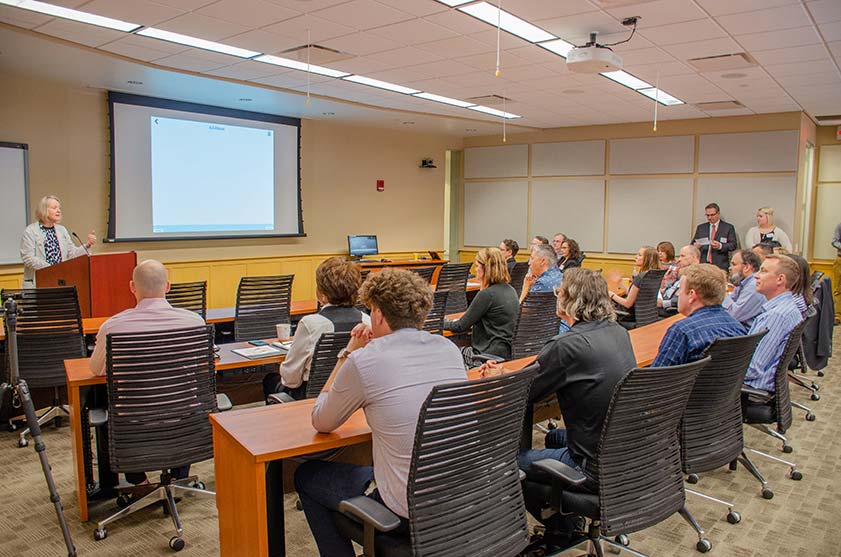
Faculty from across Ohio brought together to demonstrate health equity simulation projects

By Tyler Griesenbrock
CATALYST scientific editor
Published August 15, 2019

Profound. Exciting. Worthwhile. Inspirational. Moving.
Those were some of the words used by attendees to describe the Medicaid Equity Simulation (MES) Statewide Showcase as it came to a close June 21.
The event, hosted by The Ohio State University in collaboration with the Ohio Department of Medicaid and the Ohio Colleges of Medicine Government Resource Center, attracted faculty and clinicians from across the state.
“We have six medical schools represented today,” said Sheryl Pfeil, MD, the medical director of the Clinical Skills Education and Assessment Center as well as a clinical professor with the Division of Gastroenterology Hepatology and Nutrition at Ohio State.
In addition to local participants from Ohio State and Nationwide Children’s Hospital, visitors made the trip to Columbus from Case Western Reserve University, Ohio University, the University of Cincinnati, the University of Toledo, and Wright State University to present the health equity simulations they have developed.
All of the presentations fit into the overarching theme of using simulations to better train health care professionals in their interactions with Medicaid-enrolled populations. The project is funded through the state’s Medicaid Technical Assistance and Policy Program, or MEDTAPP.
Dr. Pfeil said the day was intended as an opportunity for attendees to experience others’ projects and share their own work. She likened many of the presentations to tapas, allowing people to come and go as they sampled the offerings from each institution .
Staff with Ohio State’s CATALYST – the Center for the Advancement of Team Science, Analytics, and Systems Thinking in Health Services and Implementation Science Research – handled the organization of the day’s activities. CATALYST also is responsible for an evaluation program that is looking at the effectiveness of the various health equity simulation projects developed by Ohio State for its MES award.
 Mary S. Applegate, MD, FAAP, FACP, the medical director for the Ohio Department of Medicaid, speaks June 21 at the Medicaid Equity Simulation (MES) Statewide Showcase. The event attracted faculty and clinicians from across the state. (Photo by Jiabin Shen/used with permission)
Mary S. Applegate, MD, FAAP, FACP, the medical director for the Ohio Department of Medicaid, speaks June 21 at the Medicaid Equity Simulation (MES) Statewide Showcase. The event attracted faculty and clinicians from across the state. (Photo by Jiabin Shen/used with permission)
“I, for one, have been waiting for this day for a very long time, because I was so excited to hear from all of your deans that you supported the idea of creating scenarios that bring insight and understanding to people,” said Mary S. Applegate, MD, FAAP, FACP, the medical director for the Ohio Department of Medicaid.
“So if you’ve never been in a wheelchair before, how does it feel to have everybody always looking down at you? Or if you’re an obstetrician, how does it feel to be told you have to be on bed rest because you didn’t do something right?” Dr. Applegate asked. “This sort of innovation can lead to greater understanding and communication with patients, which impacts their health outcomes.”
Among the Ohio State faculty presenting at the showcase was Douglas Danforth, PhD, an associate professor in the Department of Obstetrics and Gynecology. Dr. Danforth was offering demonstrations of a virtual patient built to have limited proficiency in English, and his work has recently been covered by the Columbus Dispatch and WOSU Public Media.
Lorin Ranbom, the director of the Government Resource Center, called the event “a groundbreaking achievement.”
Ranbom reflected on the group that had come together: “Six universities, with this level of partnership and collaboration, meeting the needs of a state Medicaid agency, which is wholly invested in population health, health equity, and improving the patient experience of care.”
“Seeing life through the patient’s eyes so that providers are better able to provide exceptional care and better patient outcomes is what this is about,” he said. “Universities are at the technological forefront of understanding and better addressing the underlying social and cultural challenges (that patients face.)”
Ranbom’s main takeaway from the event, he said, was that “providers are learning how to use these lessons to improve care.”
For more information about MEDTAPP, visit grc.osu.edu/MEDTAPP. For more information about CATALYST, visit go.osu.edu/catalyst.
The Medicaid Equity Simulation Project is funded by the Ohio Department of Medicaid and administered by the Ohio Colleges of Medicine Government Resource Center. The views expressed in this story are solely those of the authors and do not represent the views of the state of Ohio or federal Medicaid programs.
